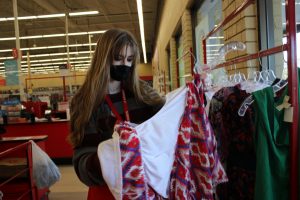Your donation will support the student journalists of Marquette High School. Your contribution will allow us to purchase equipment and cover our annual website hosting costs. You may become a PATRON by making a donation at one of these levels: White/$30, Green/$50, Blue/$100. Patron names will be published in the print newsmagazine, on the website and once per quarter on our social media accounts.
In-Depth: Thrifting Rises in Popularity
April 29, 2021
On a typical Saturday, while many teenagers are spending time with friends or family, Valarie Inch, sophomore, is organizing clothes at her part-time job.
Inch has been working at the Ellisville Savers, a thrift store, since November.
“I’ve definitely noticed more people come into the store in the past year or so,” Inch said. “It’s great that thrifting has helped people find their style, but I just hope that it sticks with people, and they don’t give up after the trend has died.”
What used to be considered an activity done by people of low-income levels out of necessity has turned into a trend for many people of high or middle-income levels. In fact, there has been a striking increase in people of middle income levels shopping at thrift stores in the past two years, according to a study conducted at Penn State University.
ENVIRONMENTAL EFFECTS & FAST FASHION
Inch said she prefers buying her clothes from thrift stores as she is extremely environmentally conscious.
On average, Americans throw away 10.5 million tons of clothing each year, according to the Student Environment Resource Center at University of California, Berkeley. Since the fashion industry is moving at a rapid pace, companies are rapidly mass producing inexpensive clothing in response to the latest trends, which is referred to as fast fashion.
As a result, a greater amount of clothing and waste is generated.
The study also states that 60 percent of clothing worldwide is made of plastic. When consumers trash these clothes, they could land up in landfills for hundreds of years.
“By buying thrifted clothes, I am reducing the amount of waste that ends up in landfills because I’m constantly reusing and repurposing old clothes,” Inch said.
Inch said Savers donates all clothing that isn’t sold by a certain time to the Vietnam Veterans Charity, therefore limiting the amount of waste produced.
Inch isn’t alone in her feelings as nine in 10 Generation Z shoppers between 6 and 24 years old believe they have a responsibility to address environmental issues, according to the McKinsey “The State of Fashion” 2019 report.
Hope Goodyear, junior, picked up thrifting as a hobby two years ago for similar reasons.
“I don’t want to take away from anyone who needs it, so I try my best to buy things that I really want and make sure to leave the things I don’t need,” Goodyear said.
Goodyear prefers stores such as the Goodwill Outlet, where all the leftover clothes from thrift stores are pooled into bins and bought in bulk. She said it’s a last chance to buy those clothes and keep them out of the landfill.
“It’s so popular right now because people of all ages and genders can find something for them, and it’s nice to get a piece of clothing that might have a story behind it,” Goodyear said.
Despite the popularity of thrifting, fast fashion remains extremely popular.
Carter Gleason, sophomore, does most of his shopping at stores such as Nike, Adidas and Vans.
“I usually go for stuff that’s the most mainstream and accessible,” Gleason said.
Gleason said he wants to dabble in thrifting but finds it to be inconvenient in comparison to fast fashion stores.
“Buying from fast fashion stores is not 100 percent ethically correct, but it’s pretty difficult to find an alternative,” Gleason said. “Any company not using fast fashion is probably gonna be more expensive or lower quality.”
Due to the effects of fast fashion shopping, many teenagers have found alternatives.
RESELLING
One alternative avenue is buying from apps such as Depop and Poshmark, which allow users to buy secondhand clothes online.
Rachel Steurer, senior, runs a shop named “Inlovewithalibra” on Depop, which she started two years ago as a means to make some additional income.
Rather than selling her clothes to thrift stores that buy clothes, such as Plato’s Closet and Avalon, Steurer opts for selling them on Depop as she makes a greater profit from the app.
She said she changes pieces completely by making simple alterations.
“One time, I bought a two-piece skirt and jacket from Savers, and I changed it by cropping the jacket and bringing up the skirt’s hem to make it high-waisted,” Steurer said. “Originally it looked like something a grandma would wear, but ended up fitting the latest trend for teens.”
Steurer said she tries to shop and sell ethically by not marking up the prices too high.
“Giving anything a new purpose and new life to be enjoyed by someone is such a cool experience,” Steurer said.
PRICING
Aside from the environmental benefits, a major attraction behind thrift shopping are the low prices.
For this reason, Jenny Chiu, junior, has been shopping at thrift stores her entire life. She said her mom enjoyed buying clothes at a discounted rate, and Chiu continues to do so on her own.
“That’s just how I was raised,” Chiu said. “Honestly there’s probably only one or two things in my closet that I’ve bought brand new or at full price.”
Chiu said the trend is beneficial to both consumers and sellers.
“I don’t think it’s ethically wrong because we’re still reusing clothes and helping out the industry,” Chiu said. “But I am really against teenagers who don’t necessarily have a dire need to thrift, yet choose to shop at stores in low-income areas because that’s super damaging.”
Anne Smith, instructor of economics at Maryville University, said the rise in thrifting will increase the price of secondhand items.
“This increase in demand for goods sold at these stores will likely increase the market price for them, and make purchasing the goods more expensive,” Smith said.
Smith compares this increased demand of “inferior goods” to generic brand cereals.
“When your income decreases, you will increase your demand for generic cereal in lieu of the really good stuff,” Smith said. “As we say in economics, when incomes fall, the demand for an inferior good will increase.”
Smith said the root of overpricing is not overconsumption, but overproduction. Fast fashion stores are producing more than is being consumed, so they end up in thrift stores where trendy teens purchase them. This then hikes up the prices for all goods within these stores.
Steve Schmitt, math teacher, has been thrifting since 2010, when he went through a divorce that left him in need of many new items and not much money to buy them. He found that thrift stores often carried a wide variety of furniture, clothing and kitchen supplies for half the price of chain stores.
Over the past 11 years, Schmitt’s financial situation has improved; however, he is still an avid thrifter.
“Nowadays, it’s the thrill of the hunt partly because it’s just fun to go with no pressure of needing something and looking for things that jump out at you,” Schmitt said. “It’s the joy of finding something that brings me joy.”
Typically, Schmitt searches for books, kitchenware and gardening supplies and doesn’t make clothing a top priority.
He also encourages his two daughters to do the same.
“At first, my daughters would roll their eyes and be like ‘Dad, I can’t believe you’re doing this,’ but now that they’re in the adult world and have their own jobs, they’ve started thrifting as well,” Schmitt said. “If you’re getting something for a good price, why not?”








